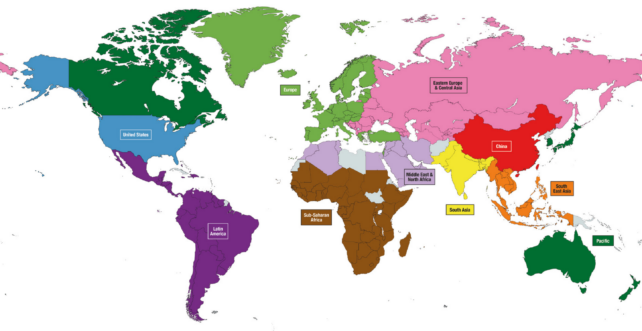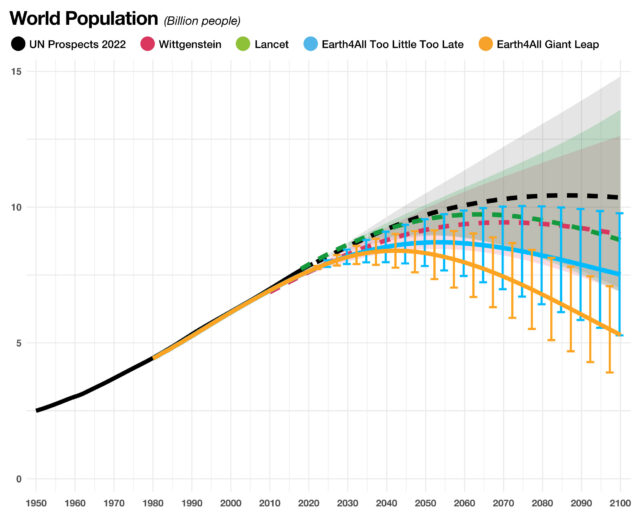The number of humans on Earth reached 8 billion in November 2022.
Now a new report suggests that the world's population may peak at just 9 billion by 2050, a number far lower than previously thought.
Compared to other more well-known estimates, such as those from the United Nations, the latest prediction is either a breath of fresh air, or an omen of disaster.
The pros and cons of Earth's growing human population are hotly debated, with proponents citing positive effects on the economy and technology and critics emphasizing the risks to the environment and social harmony.
While it could be argued that smaller populations require less energy, housing, food, and water, there are some significant caveats. Most importantly, an imminent reversal of population growth means we need major investments in education and health, not to mention ways to overcome economic inequality in an aging society.
"These extraordinary turnarounds are designed as policy and investment road maps that will work for the majority of people," the authors write in their report.
"They are not an attempt to create some impossible-to-reach utopia; instead, they are an essential foundation for a resilient civilization on a planet under extraordinary pressure."
The report's predictions are based on extensive research, and much of it shows that the top 10 percent of the wealthiest people in the world are mostly responsible for the overconsumption that threatens the stability of the environment. Including climate change.
"Humanity's main problem is luxury carbon and biosphere consumption, not population," says environmental scientist Jorgen Randers, one of the modelers for Earth4All, the initiative that worked with the Global Challenges Foundation to create this report.
"The places where population is rising fastest have extremely small environmental footprints per person compared with the places that reached peak population many decades ago."
The authors predicted how to manage population growth in each major region using scientific data, with a goal to form a human population that can thrive on Earth for a long time.
Ten countries and regions are considered in the analysis, from China to the United States to Sub-Saharan Africa. Currently, population growth rates are highest in several African nations, such as Angola, Niger, the Democratic Republic of Congo and Nigeria, as well as in some Asian countries, such as Afghanistan.

Using a recently built dynamics model, the researchers looked into two different scenarios that could take place this century.
The first scenario, grimly titled "Too Little Too Late," imagines the world meandering along much as it has since 1980. This is predicated on the assumption that variables such as birth rates, savings and debt levels, tax rates, and income models will continue their current patterns.
This scenario forecasts a global population peak of 8.8 billion in the middle of this century and a gradual decline to 7.3 billion in 2100.
Global inequality, ecological footprints, and wildlife extinction will rise as economic and population growth slows. Regional collapses may increase as social divisions within and between countries grow, especially in countries with weak economies and poor governments.
In the more hopeful scenario, called the "Giant Leap," the global population peaks at 8.5 billion by around 2040 and declines to just six billion by the end of the century. The authors indicate that one of the deciding factors in this optimistic outcome is that economic inequality around the world is recognized as a source of division and a threat to democracy and human progress.
In this hypothetical future, extreme poverty would be eliminated by the year 2060, which would have a profound impact on global population growth.
This turnaround requires massive poverty reduction investments and revolutionary food and energy security, inequality, and gender equality policies.
"A good life for all is only possible if the extreme resource use of the wealthy elite is reduced," explains Randers.

Other major projections overlook rapid economic development as a solution to rising populations, according to the authors.
"Few prominent models simulate population growth, economic development and their connections simultaneously," states economist Beniamino Callegari, one of the authors of the report.
What's more, the UN's modeling approach fails to explain trends' origins and future changes, according to the report. For instance, why and how a society's birth and death rates deviate from historical norms and what that means for its future.
"We know rapid economic development in low-income countries has a huge impact on fertility rates," adds co-author, psychologist and economist Per Espen Stoknes. "Fertility rates fall as girls get access to education and women are economically empowered and have access to better healthcare."
More research and some big changes are undoubtedly required.
The authors note, "What we aimed to achieve with our scenarios is to illustrate that (1) demographic, socio-economic and natural change is possible, and (2) its magnitude and ultimate impact will depend primarily on the actions we are going to take in this decade."
This report has been published as a working paper titled: People and Planet: 21st Century Sustainable Population Scenarios and Possible Living Standards Within Planetary Boundaries.
